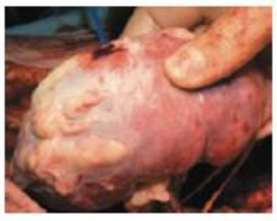
Concept explainers
Since the 1950s, when living kidney donation was first recognized as a viable alternative to cadaver organ donors, family and friends have come forward to offer a kidney to a victim of kidney failure. To reduce the chance that the recipient’s immune system will attack the donated kidney as if it were an invading microbe or
To remove a donor kidney (FIG. 36-9), surgeons generally use a technique called laparoscopic surgery, where they make half-inch incisions through which they insert surgical tools, including a tiny video camera to guide the operation. The kidney is extracted through an incision about 2½ inches long, put on ice, and rushed to its recipient. The operation takes 3 to 4 hours; donors remain in the hospital for about 3 days and return to work in about 3 weeks. In addition to the risks associated with major surgery, kidney donors will lack a backup kidney in the unlikely event that their remaining kidney fails. But a recent study of deaths among 80,000 kidney donors during a 15-year period found no greater mortality among this group (once they had recovered from their surgery) than among non-donors.

FIGURE 36-9 Surgeons transplant a kidney
Domino donations are almost always started spontaneously by someone inspired to make a difference. Since 2008, when DeGiulio’s donated kidney started a chain that saved four lives (FIG. 36-10), such domino donation chains have become longer and more frequent. For example, during a 4-month period, 17 hospitals in 11 states from California to New Jersey matched 30 people—who might otherwise have died—with kidneys from 30 donors they had never met. This heroic enterprise was started by Good Samaritan Rick Ruzzamenti, who got the idea from the desk clerk at his yoga studio, who had mentioned to him that she had donated a kidney to a friend. “People think it’s so odd that I’m donating a kidney,” he told the transplant coordinator at his hospital, but “I think it’s so odd that they think it’s so odd. . . . It causes a shift in the world.”

FIGURE 36-10 Domino donations Kidneys from compatible strangers saved the lives of these four recipients.
The more than 100,000 eligible individuals awaiting a kidney transplant ardently hope that domino donation chains continue to be forged and to lengthen.
CONSIDER THIS Would you donate a kidney to a friend or family member whose kidneys were failing? Would you consider donating a kidney to a stranger? Explain your reasoning.
Want to see the full answer?
Check out a sample textbook solution
Chapter 36 Solutions
Biology
- A pharmaceutical company has developed a new weight loss drug for adults. Preliminary tests show that the drug seems to be fairly effective in about 75% of test subjects. The drug company thinks that the drug might be most effective in overweight individuals, but they are unsure to whom they should market the product. Use the scientific method to address the pharmaceutical company’s needs: State a research question that addresses the pharmaceutical company's problem Conduct online research on “Body Mass Index” categories and record a brief summary Construct a testable hypothesis and record in Design an experiment to test the hypothesis and describe the procedures, variables, and data to be collected What is the purpose of a control group in an experiment? What would the control groups be for each of your designed experiments in this exercise? Describe the data that would be recorded in each of the experiments you designed. Would it be classified as quantitative or…arrow_forwardPatients with multiple sclerosis frequently suffer from blurred vision. Drug X was developed to reduce blurred vision in healthy patients, but the effectiveness had not been tested on those suffering from multiple sclerosis. A study was conducted to determine if Drug X is effective at reducing blurry vision in multiple sclerosis patients. To be considered effective, a drug must reduce blurred vision by more than 30% in patients. Researchers predicted that a 20 mg dose of the drug would be effective for treating blurred vision in multiple sclerosis patients by reducing blurred vision by more than 30%. Drug X was administered to groups of multiple sclerosis patients at three doses (10 mg/day, 20 mg/day, 30 mg/day) for three weeks. A fourth group of patients was given a placebo containing no drug X for the same length of time. Vision clarity was measured for each patient before and after the three-week period using a standard vision test. The results were analyzed and graphed (See Figure…arrow_forwardSvp je voulais demander l aide pour mon exercicearrow_forward
- Imagine that you are a clinical geneticist. Your colleague is an oncologist who wants your help explaining the basics of genetics to their patient, who will be undergoing genetic testing in the coming weeks for possible acute myeloid leukemia (AML) induced by the radiation she had several years ago for breast cancer. Write a 1,050- to 1,225-word memo to your colleague. Include the following in your memo: An explanation of the molecular structure of DNA and RNA, highlighting both similarities and differences A description of the processes of transcription and translation An explanation of the differences between leading and lagging strands and how the DNA is replicated in each strand Reponses to the following common questions patients might ask about this type of genetic testing and genetic disorder: Does AML run in families? What genes are tested for?arrow_forwardRespond to the following in a minimum of 175 words: What are some potential consequences that could result if the processes of replication, transcription, and translation don’t function correctly? Provide an example of how you might explain these consequences in terms that patients might understand.arrow_forwardanswer questions 1-10arrow_forward
- Answer Question 1-9arrow_forwardEx: Mr. Mandarich wanted to see if the color of light shined on a planthad an effect on the number of leaves it had. He gathered a group ofthe same species of plants, gave them the same amount of water, anddid the test for the same amount of time. Only the color of light waschanged. IV:DV:Constants:Control Gr:arrow_forwardethical considerations in medical imagingarrow_forward
- Please correct answer and don't used hand raiting and don't used Ai solutionarrow_forward2. In one of the reactions of the citric acid cycle, malate is oxidized to oxaloacetate. When this reaction is considered in isolation, a small amount of malate remains and is not oxidized. The best term to explain this is a. enthalpy b. entropy c. equilibrium d. free energy e. loss of energyarrow_forward18. The citric acid cycle takes place in a. the chloroplasts b. the cytosol c. the inner mitochondrial membrane d. between the two mitochondrial membranes e. the mitochondrial matrix 40 WILarrow_forward
 Human Biology (MindTap Course List)BiologyISBN:9781305112100Author:Cecie Starr, Beverly McMillanPublisher:Cengage Learning
Human Biology (MindTap Course List)BiologyISBN:9781305112100Author:Cecie Starr, Beverly McMillanPublisher:Cengage Learning Human Physiology: From Cells to Systems (MindTap ...BiologyISBN:9781285866932Author:Lauralee SherwoodPublisher:Cengage Learning
Human Physiology: From Cells to Systems (MindTap ...BiologyISBN:9781285866932Author:Lauralee SherwoodPublisher:Cengage Learning Comprehensive Medical Assisting: Administrative a...NursingISBN:9781305964792Author:Wilburta Q. Lindh, Carol D. Tamparo, Barbara M. Dahl, Julie Morris, Cindy CorreaPublisher:Cengage Learning
Comprehensive Medical Assisting: Administrative a...NursingISBN:9781305964792Author:Wilburta Q. Lindh, Carol D. Tamparo, Barbara M. Dahl, Julie Morris, Cindy CorreaPublisher:Cengage Learning Human Heredity: Principles and Issues (MindTap Co...BiologyISBN:9781305251052Author:Michael CummingsPublisher:Cengage Learning
Human Heredity: Principles and Issues (MindTap Co...BiologyISBN:9781305251052Author:Michael CummingsPublisher:Cengage Learning





